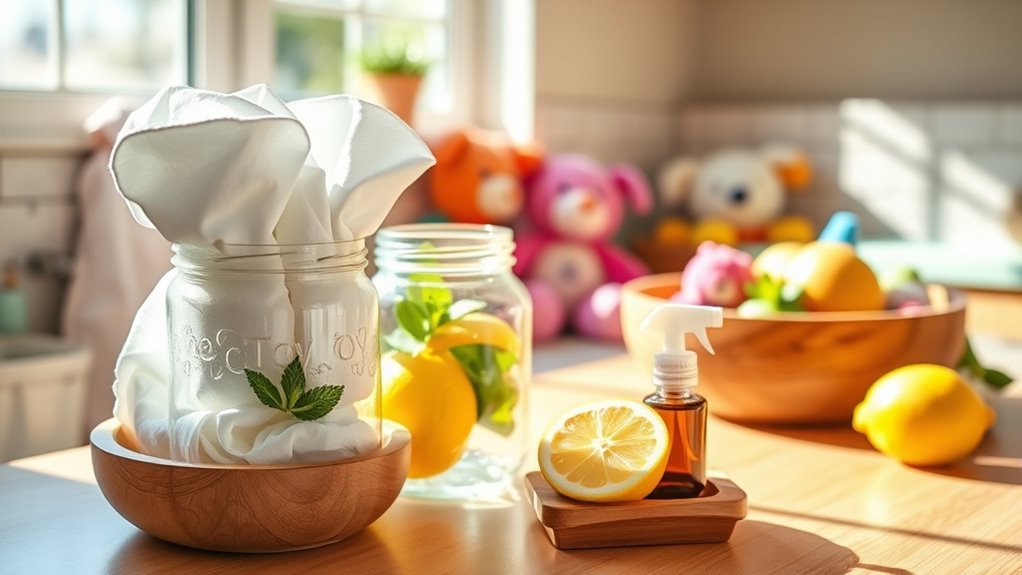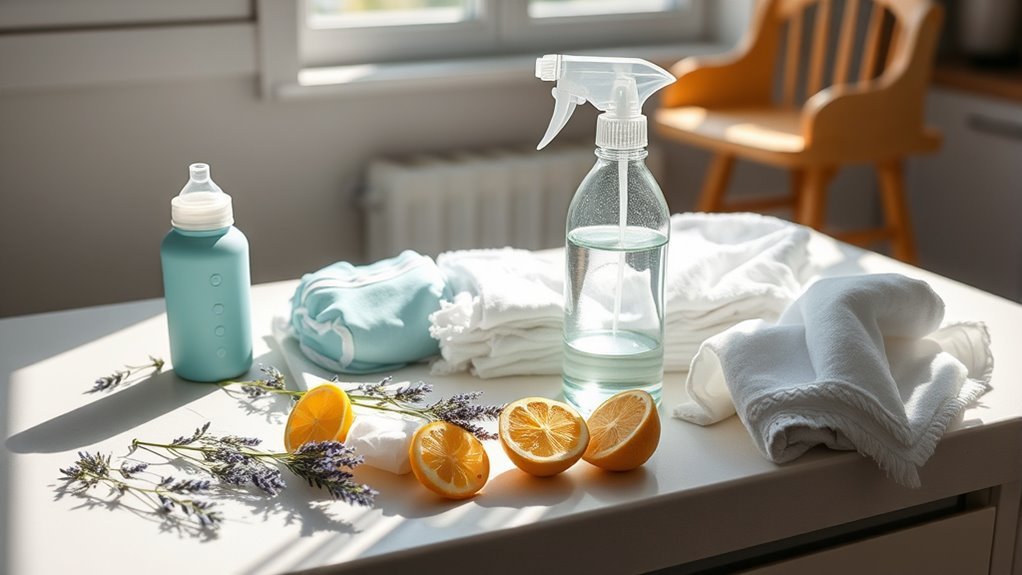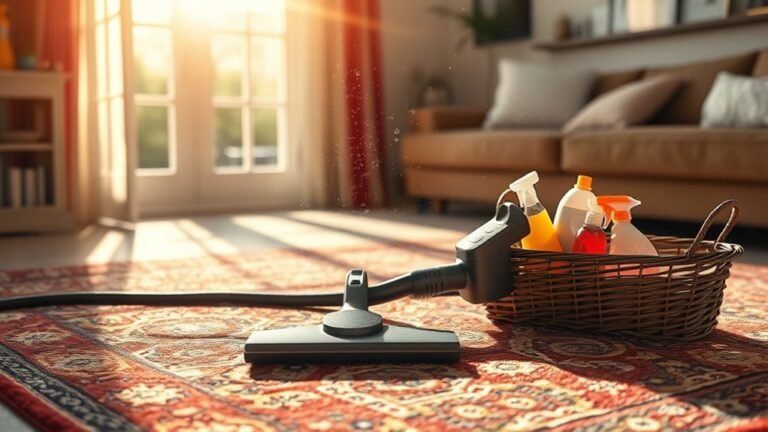Natural Cleaning Hacks for Your Baby Items
You can keep your baby’s items clean and safe using natural ingredients like vinegar, baking soda, and mild castile soap. These gently remove grime and kill germs without harsh chemicals. Try a simple mix of white vinegar and water for disinfecting toys and surfaces or use baking soda to lift stains from clothes. Soft, fragrance-free soaps protect delicate skin, and sunlight naturally sanitizes while drying. If you want more gentle, effective cleaning tips, there’s plenty to explore.
Safe Ingredients for Homemade Baby Item Cleaners

When you’re cleaning baby items, it’s important to choose ingredients that are gentle yet effective, so you don’t risk irritating your little one’s sensitive skin. You want to embrace natural ingredients that are not only safe but also align with your eco friendly options. Ingredients like white vinegar, baking soda, and mild castile soap offer powerful cleaning without harsh chemicals. These natural choices break down grime while keeping toxins away from baby’s environment. Plus, they let you maintain freedom from synthetic additives and unnecessary irritants. Opting for these eco friendly options means you’re protecting your baby and the planet. By sticking to simple, natural ingredients, you gain peace of mind in every cleaning session, knowing you’re doing the best for your baby’s health and your values.
How to Make Natural Baby Bottle Cleaning Solution
Although cleaning baby bottles might seem straightforward, using a natural solution guarantees you’re avoiding harsh chemicals that could affect your baby’s health. To make your own natural baby bottle cleaning solution, follow these simple steps:
Cleaning baby bottles naturally ensures safety by avoiding harsh chemicals that can impact your baby’s health.
- Mix 1 cup of warm water with 1 tablespoon of white vinegar for its natural antibacterial properties.
- Add 1 teaspoon of baking soda to gently break down milk residue without harsh chemicals.
- Use a few drops of mild, fragrance-free castile soap to enhance cleaning power.
- Apply this solution with reusable cleaning materials like bottle brushes made from natural fibers to protect the environment.
After cleaning, use proper bottle sterilization techniques such as boiling or steam sterilizers to confirm your baby’s bottles are hygienic and safe. This approach keeps your routine toxin-free and eco-friendly.
DIY Organic Toy Cleaning Wipes

Keeping baby bottles clean is just one part of maintaining a safe environment for your little one. You can extend that care by making DIY organic toy cleaning wipes using eco friendly materials like cotton cloths and a gentle solution of water, castile soap, and a few drops of lavender oil. These wipes are perfect for quick clean-ups, giving you freedom from harsh chemicals. To keep them handy, store your wipes in a resealable container that offers convenient storage and maintains moisture. This way, you’re always ready to wipe down toys without hassle. Using these natural wipes not only protects your baby but also reduces waste, aligning perfectly with your desire for a cleaner, greener lifestyle. It’s simple, safe, and smart!
Vinegar-Based Spray for Disinfecting Baby Surfaces
One simple way to disinfect your baby’s surfaces is by using a vinegar-based spray that’s both natural and effective. Vinegar benefits include its ability to kill germs without harsh chemicals, making it perfect for disinfecting surfaces your little one touches daily. Here’s how you can make and use this spray:
- Mix equal parts white vinegar and water in a spray bottle.
- Add a few drops of essential oil for a fresh scent, if you like.
- Spray the solution on toys, high chairs, and changing tables.
- Wipe with a clean cloth and let air dry to guarantee full disinfecting surfaces benefits.
This vinegar-based spray gives you a safe, free-spirited way to keep baby areas clean without sacrificing your values.
Gentle Cleaning Methods for Baby Clothes and Linens

Cleaning your baby’s clothes and linens requires just as much care as disinfecting their play areas. To keep fabrics soft and safe, stick to gentle washing techniques using mild, natural detergents free from harsh chemicals. Avoid bleach or strong additives that can irritate your baby’s delicate skin. When you want to add softness, opt for natural fabric softeners like white vinegar or wool dryer balls instead of synthetic ones, which may contain allergens. Wash clothes in warm water to effectively clean without damaging fibers or causing color fading. Always rinse thoroughly to remove detergent residues. By choosing these gentle cleaning methods, you maintain your baby’s comfort and freedom to explore while ensuring their clothes and linens stay fresh, soft, and naturally clean.
Using Baking Soda to Remove Stains From Baby Gear
Wondering how to tackle stubborn stains on your baby’s gear without harsh chemicals? Baking soda is your go-to natural solution for effective stain removal and gear maintenance. It’s safe, affordable, and easy to use, giving you freedom from synthetic cleaners.
Baking soda offers a safe, natural, and affordable way to remove tough stains from your baby’s gear.
Try this simple method:
- Sprinkle baking soda directly on the stain.
- Add a few drops of water to form a paste.
- Gently scrub the area with a soft brush or cloth.
- Let it sit for 15 minutes, then rinse with warm water.
This approach lifts stains while protecting your baby’s items. Regular baking soda treatments keep gear fresh and extend its lifespan, so you can enjoy worry-free cleaning that supports your family’s health and your freedom to choose natural care.
Essential Oils That Are Safe for Baby Item Cleaning
Along with baking soda, certain natural oils can boost your baby cleaning routine by adding a fresh scent and extra antibacterial power. When choosing safe essential oils for baby item cleaning, you want to stick to gentle options like lavender, chamomile, and tea tree oil. These oils are widely recognized for their antimicrobial properties while being mild enough to respect baby item safety. Remember, always dilute essential oils properly before use to avoid irritation or damage. Avoid harsh oils like eucalyptus or peppermint, which can be too strong for delicate baby gear. By carefully selecting safe essential oils, you maintain a clean, natural environment for your little one without compromising on freedom or effectiveness. Your baby’s items will smell great and stay fresh, naturally.
Tips for Sanitizing Pacifiers Naturally
While pacifiers are a comforting staple for many babies, keeping them sanitized is essential to prevent germs from causing illness. You want to embrace freedom from harsh chemicals while ensuring safe pacifier cleaning through natural sanitation. Here are four simple tips:
- Boil pacifiers in water for 5 minutes to naturally sanitize without chemicals.
- Use a mixture of equal parts white vinegar and water to soak pacifiers for 10 minutes, then rinse thoroughly.
- Steam pacifiers using a baby bottle sterilizer or steam basket for quick, chemical-free sanitation.
- Sun-dry pacifiers after cleaning; sunlight acts as a natural disinfectant.
These methods let you confidently keep pacifiers clean and safe, giving your baby comfort without compromising on natural sanitation.
Proper Storage of Cleaned Baby Items to Maintain Hygiene
Once your baby items are clean and dry, storing them in airtight containers helps keep germs and dust away. You’ll also want to choose a drying area with good airflow to prevent moisture buildup. These simple steps make sure everything stays hygienic until the next use.
Airtight Containers Usage
Keeping baby items clean is only half the battle; storing them properly is just as important to maintain hygiene. Using airtight containers offers several benefits that help keep your baby’s essentials fresh and germ-free. When you choose airtight storage, you’re locking out dust, moisture, and bacteria, giving you peace of mind.
Here’s how to make the most of airtight containers:
- Select containers made from BPA-free materials to keep items safe.
- Label each container for easy identification, avoiding unnecessary opening.
- Store bottles, pacifiers, and toys separately to prevent cross-contamination.
- Clean and dry items thoroughly before sealing to avoid mold growth.
Drying Area Selection
Choosing the right drying area for your baby’s items is essential to prevent bacteria and mold growth. You want a spot that’s well-ventilated and ideally gets some natural sunlight benefits, as sunlight helps kill germs and keeps things fresh. Set up drying racks in a sunny area, but avoid places where dust or pets might interfere. Using drying racks not only lets air circulate freely around bottles, toys, and clothes but also speeds up drying, reducing the chance of moisture lingering. Once dry, store your baby’s items in a clean, dry place away from humidity to maintain hygiene. By thoughtfully selecting your drying area, you’re giving your little one’s belongings the freedom to stay clean and safe naturally.
Frequently Asked Questions
How Often Should I Clean My Baby’s Toys and Gear?
Imagine your baby’s toys as little castles that need regular upkeep to keep invaders at bay. When it comes to toy sanitation, frequency guidelines suggest cleaning high-touch items weekly and gear like strollers or car seats monthly. If your baby’s been sick, increase cleaning frequency to prevent germs from lingering. Staying on top of this keeps your baby’s world safe and lets you enjoy the freedom of worry-free playtime.
Can Natural Cleaners Cause Allergies in Babies?
Yes, natural cleaners can sometimes trigger allergy symptoms in babies, especially if they contain strong essential oils or fragrances. You’ll want to choose products with safe ingredients like vinegar, baking soda, or mild castile soap to minimize risks. Always test a small area first and watch for any reactions. By selecting gentle, safe ingredients, you can keep your baby’s environment clean without compromising their health or your freedom to use natural solutions.
What Are Signs of Residue Left From Cleaning Products?
When you’re checking for residue detection after cleaning, watch for sticky or slippery surfaces and any unusual smells left behind. If your baby’s skin gets irritated or develops a rash, that’s a big red flag about cleaning product safety. You want to feel confident that no harmful chemicals linger, so rinse thoroughly and pick gentle, natural cleaners. Trust your instincts—your freedom to choose safe, residue-free items is key to peace of mind.
Are There Natural Cleaning Hacks for Baby Car Seats?
Yes, you can definitely use natural cleaning hacks for your car seat. Start by mixing equal parts water and white vinegar in a spray bottle—it’s great for breaking down grime without harsh chemicals. For fabric parts, sprinkle baking soda, let it sit to absorb odors, then vacuum. These cleaning tips help keep your car seat fresh and safe, giving you freedom from worrying about toxic residues while on the go with your baby.
How to Clean Baby Items While Traveling Without Natural Ingredients?
When you’re on the go, portable cleaning solutions are a lifesaver for baby items. Pack travel essentials like disinfectant wipes, antibacterial sprays, and a small microfiber cloth. These let you quickly clean surfaces without hassle, so you can keep your baby’s things fresh and safe wherever you are. With these tools, you won’t feel tied down, giving you the freedom to explore while staying prepared for any mess or spill.






